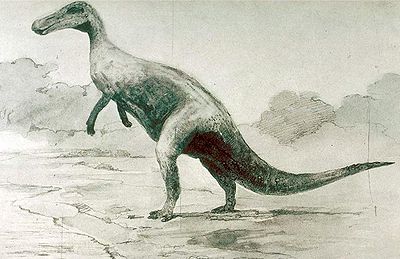Thespesius: Różnice pomiędzy wersjami
m |
|||
| Linia 1: | Linia 1: | ||
| − | |||
| − | |||
{{DISPLAYTITLE:''Thespesius''}} | {{DISPLAYTITLE:''Thespesius''}} | ||
<small> | <small> | ||
| Linia 8: | Linia 6: | ||
|- | |- | ||
| [[Maciej Ziegler]] | | [[Maciej Ziegler]] | ||
| − | | | + | | [[Kamil Kamiński]] |
|}</small> | |}</small> | ||
| Linia 67: | Linia 65: | ||
| ''T. edmontoni'' | | ''T. edmontoni'' | ||
| {{Kpt|[[Charles Gilmore|Gilmore]]}}, [[1924]] | | {{Kpt|[[Charles Gilmore|Gilmore]]}}, [[1924]] | ||
| − | | = ''[[Edmontosaurus]] | + | | = ''[[Edmontosaurus]] regalis'' |
|- | |- | ||
| = ''T. edmontonensis'' | | = ''T. edmontonensis'' | ||
| Linia 73: | Linia 71: | ||
| ''T. saskatchewanensis'' | | ''T. saskatchewanensis'' | ||
| {{Kpt|[[Charles M. Sternberg|Sternberg]]}}, [[1926]] | | {{Kpt|[[Charles M. Sternberg|Sternberg]]}}, [[1926]] | ||
| − | | = ''[[Edmontosaurus]] | + | | = ''[[Edmontosaurus]] annectens'' |
|} | |} | ||
== Bibliografia == | == Bibliografia == | ||
| − | <small> | + | <small> Campione, N. S. E. & Evans, D. C. (2011). "Cranial Growth and Variation in ''Edmontosaurs'' (Dinosauria: Hadrosauridae): Implications for Latest Cretaceous Megaherbivore Diversity in North America". PLOS ONE. 6 (9): e25186. [[doi:10.1371/journal.pone.0025186]]. |
| + | |||
| + | |||
Horner, J.R., Weishampel, D.B. & Forster, C.A. (2004) "Hadrosauridae" [w:] Weishampel, D.B., Dodson, P. & Osmólska, H. "The Dinosauria" Berkeley and Los Angeles: University of California Press, 438–463 | Horner, J.R., Weishampel, D.B. & Forster, C.A. (2004) "Hadrosauridae" [w:] Weishampel, D.B., Dodson, P. & Osmólska, H. "The Dinosauria" Berkeley and Los Angeles: University of California Press, 438–463 | ||
</small> | </small> | ||
| Linia 92: | Linia 92: | ||
[[Kategoria:Mastrycht]] | [[Kategoria:Mastrycht]] | ||
[[Kategoria:Nomen dubium]] | [[Kategoria:Nomen dubium]] | ||
| − | |||
Wersja z 11:17, 7 paź 2022
| Autor: | Korekta: |
| Maciej Ziegler | Kamil Kamiński |
| Thespesius | |
|---|---|
| Długość: | ? m |
| Masa: | ? t |
| Miejsce występowania: | USA - Dakota Południowa i Montana
(formacja Lance) |
| Czas występowania | 68-65 Ma |
| Systematyka | Dinosauria |

Klasyczna rekonstrukcja Thespesius autorstwa Charlesa Knighta z 1901 r. [1] | |
Wstęp
Thespesius to wątpliwy rodzaj hadrozauryda znany z dwóch kręgów ogonowych i paliczka. Szczątki przechowywane są w Muzeum Historii Naturalnej w Waszyngtonie oznaczone jako USNM 219, USNM 220 i USNM 221.
Lokalizacja
Zebrano je w Dakocie Południowej (Stany Zjednoczone) z osadów formacji Lance. Wiek tej formacji datuje się na późny mastrycht - 68-65 Ma. Co ciekawe, początkowo myślano, że szczątki Thespesius pochodzą z miocenu.
Ważność taksonu
Gatunek typowy - T. occidentalis uznawany jest za nomen dubium, a pozostałe zostały przeniesione do Edmontosaurus.
Spis gatunków
| Thespesius | Leidy, 1856 | nomen dubium |
| T. occidentalis | Leidy, 1856 | nomen dubium |
| T. edmontoni | Gilmore, 1924 | = Edmontosaurus regalis |
| = T. edmontonensis | ||
| T. saskatchewanensis | Sternberg, 1926 | = Edmontosaurus annectens |
Bibliografia
Campione, N. S. E. & Evans, D. C. (2011). "Cranial Growth and Variation in Edmontosaurs (Dinosauria: Hadrosauridae): Implications for Latest Cretaceous Megaherbivore Diversity in North America". PLOS ONE. 6 (9): e25186. doi:10.1371/journal.pone.0025186.
Horner, J.R., Weishampel, D.B. & Forster, C.A. (2004) "Hadrosauridae" [w:] Weishampel, D.B., Dodson, P. & Osmólska, H. "The Dinosauria" Berkeley and Los Angeles: University of California Press, 438–463